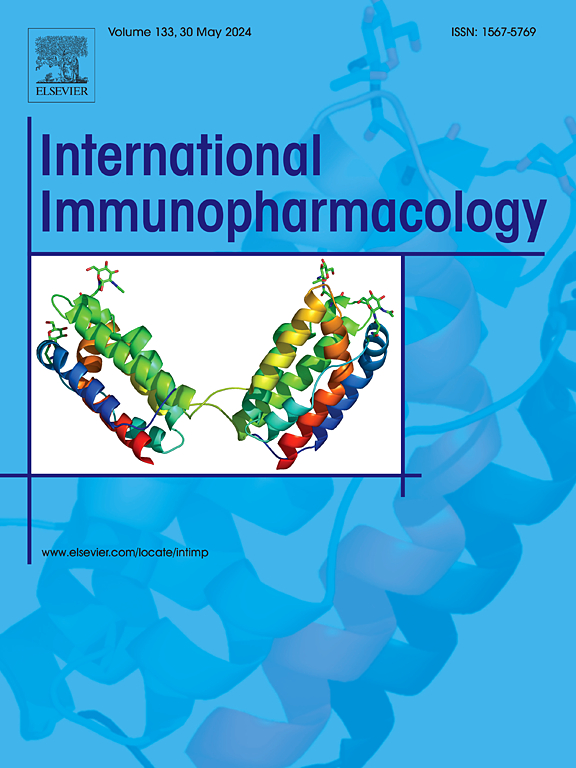FBLIM1通过wtap介导的m6A修饰,调控TGF-β信号通路,驱动胆管结合法肝纤维化
IF 4.7
2区 医学
Q2 IMMUNOLOGY
引用次数: 0
摘要
肝纤维化是梗阻性黄疸的主要严重病理后果之一,迫切需要有效的治疗策略。纤维蛋白结合LIM蛋白1 (FBLIM1)与纤维化有关,然而,没有证据表明FBLIM1对梗阻性黄疸有影响。方法研究FBLIM1在大鼠胆管结扎(BDL)模型和人肝星状细胞(HSC) LX-2中的功能。结果FBLIM1在BDL大鼠肝组织中高表达。FBLIM1敲低可减轻BDL大鼠的肝脏病理损伤、肝纤维化和炎症反应。FBLIM1敲低可阻断BDL大鼠TGF-β信号通路。TGF-β1刺激LX-2细胞的结果进一步证实FBLIM1通过调节TGF-β信号通路促进LX-2细胞活化和纤维化。进一步证实FBLIM1受Wilms's tumor 1- associated protein (WTAP)的调控,WTAP在BDL大鼠肝组织中高表达。WTAP稳定FBLIM1 mRNA,并以m6a依赖的方式调节FBLIM1的表达。结论FBLIM1通过wtap介导的m6A修饰,通过调控TGF-β信号通路促进肝纤维化。WTAP/FBLIM1/TGF-β轴可能是治疗梗阻性黄疸的潜在靶点。本文章由计算机程序翻译,如有差异,请以英文原文为准。
FBLIM1 drives bile duct ligation-induced liver fibrosis by regulating the TGF-β signaling pathway through WTAP-mediated m6A modification
Background
Liver fibrosis is one of the main severe pathological consequences of obstructive jaundice, and an effective treatment strategy is urgently needed. Filamin-binding LIM protein 1 (FBLIM1) is associated with fibrosis, however, there is no evidence to show the effect of FBLIM1 on obstructive jaundice.
Methods
In our study, we investigated the function of FBLIM1 in bile duct ligation (BDL) rat models and human hepatic stellate cell (HSC) line LX-2.
Results
Our findings confirmed that FBLIM1 was highly expressed in liver tissues of BDL rats. Liver histopathological injury, liver fibrosis, and inflammation response in BDL rats were attenuated by FBLIM1 knockdown. Moreover, FBLIM1 knockdown blocked the TGF-β signaling pathway in BDL rats. The results in TGF-β1-stimulation LX-2 cells further confirmed that FBLIM1 promoted LX-2 cell activation and fibrosis by regulating the TGF-β signaling pathway. FBLIM1 was further demonstrated to be modulated by Wilms's tumor 1-associating protein (WTAP), which was highly expressed in liver tissues of BDL rats. WTAP stabilized FBLIM1 mRNA and regulated FBLIM1 expression in an m6A-dependent manner.
Conclusion
Our findings provide evidence indicating that FBLIM1 promotes liver fibrosis via regulating the TGF-β signaling pathway through WTAP-mediated m6A modification. The WTAP/FBLIM1/TGF-β axis may be a potential therapeutic target against obstructive jaundice.
求助全文
通过发布文献求助,成功后即可免费获取论文全文。
去求助
来源期刊
CiteScore
8.40
自引率
3.60%
发文量
935
审稿时长
53 days
期刊介绍:
International Immunopharmacology is the primary vehicle for the publication of original research papers pertinent to the overlapping areas of immunology, pharmacology, cytokine biology, immunotherapy, immunopathology and immunotoxicology. Review articles that encompass these subjects are also welcome.
The subject material appropriate for submission includes:
• Clinical studies employing immunotherapy of any type including the use of: bacterial and chemical agents; thymic hormones, interferon, lymphokines, etc., in transplantation and diseases such as cancer, immunodeficiency, chronic infection and allergic, inflammatory or autoimmune disorders.
• Studies on the mechanisms of action of these agents for specific parameters of immune competence as well as the overall clinical state.
• Pre-clinical animal studies and in vitro studies on mechanisms of action with immunopotentiators, immunomodulators, immunoadjuvants and other pharmacological agents active on cells participating in immune or allergic responses.
• Pharmacological compounds, microbial products and toxicological agents that affect the lymphoid system, and their mechanisms of action.
• Agents that activate genes or modify transcription and translation within the immune response.
• Substances activated, generated, or released through immunologic or related pathways that are pharmacologically active.
• Production, function and regulation of cytokines and their receptors.
• Classical pharmacological studies on the effects of chemokines and bioactive factors released during immunological reactions.

 求助内容:
求助内容: 应助结果提醒方式:
应助结果提醒方式:


